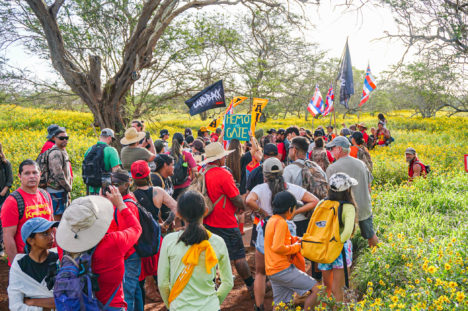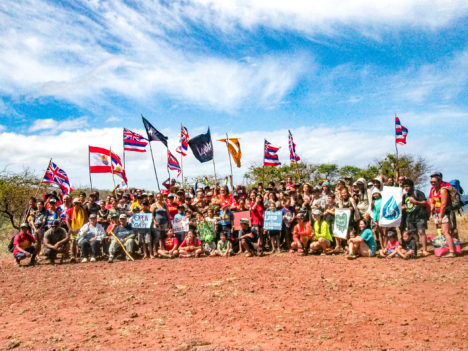March for Kawakiu Access
By Catherine Cluett Pactol and Jack Kiyonaga
At 7 a.m. last Saturday, more than 100 Molokai residents stood at the gated entrance to Kawakiu, an area of west Molokai owned by Molokai Properties Limited, also known as Molokai Ranch. For those gathered, Kawakiu represents not only a cultural and historic site, but also generational subsistence grounds.
“We’re walking for our young people so they can go hunting and fishing here… it’s a constant battle to keep your rights alive,” said activist Walter Ritte to the gathered crowd waiting to march the dirt road that is currently blocked to the beach. “Kawakiu is a historic site, there are burials over there, house sites over there, heiau over there.”
Forty-eight years ago, on Oct. 3, 1975, then-Mayor Elmer Carvalho joined the community in opening the gate and proclaimed, “May this gate never be closed again.” The battle for access at that time had wide-reaching impacts, including constitutional protections for Native Hawaiian rights.
Since then, road access to Kawakiu remained open — until recently.
“We’re talking about our rights of access,” explained Ritte last Saturday. He said the currently-installed gate represented a “huge insult” to the work that was already done.
Ritte said organizers of the planned protest had been told the day before that a hunt was scheduled for Saturday. He advised participants to stay together and stay on the roadway.
The large group, ranging in age from young keiki to kupuna, joined in pule and sang “Molokai Nui A Hina” before breaching the locked gate to Kawakiu. Carrying flags and signs, marchers walked the more than a mile to the beach.
Stopping at a recently-build ahu near the beach’s entrance, cultural practitioner Kanoelani Davis performed protocol to bless the site and community members shared offerings.
“A form of resistance is practicing our culture, however that is,” she told the crowd. “Whether chants, pule, offerings, through language, through practicing our lawai’a, being responsible stewards of this ‘aina. No matter what we do as kanaka, that is our responsibility and that is our resistance and that is more than enough.”
Davis said the site represented an important place for “not just one ‘ohana but likely all of our ‘ohana has been here.”
“This ‘aina wasn’t only for fishermen but for hunters and this was also a safe place for people to come during the winter months so this is where they would come on this west side to live until the big swells were done,” explained Davis. “So this is where they would gather pa’akai, this is where they would gather their fish and dry it.”
Ritte echoed the area’s significance.
“We know this place was used by our kupuna throughout the whole year,” he said. “The site has the most fish hooks of any of the sites found so far in Hawaii, so this place was well-used by fishermen.”
Sitting on the rocks overlooking Kawakiu beach as keiki played in the water, Walter Mendes reflected on what the place meant to him. He was one of the original participants in the march to open up access 48 years ago.
“I never thought that would happen again, but I guess it’s still going,” he said. “It’s for the generations to come, so they can enjoy this. We gotta eat. I usually come here to collect salt, pick ‘opihi, throw net, dive.”
After arriving at Kawakiu beach, protest participant Byron Espaniola shared some of his ‘ohana’s connection to the site.
“My connection is my family outings and gatherings here. We not only brought back opihi, salt and fish but a lot of good memories…” he said. “It’s just a place of peace, kindness and reflection.”
Closing the access road “confirmed in me my disappointment in state laws…[the protest] is a form of home rule. I believe in home rule,” said Espaniola.
Another participant in the protest, Mike Soares, spoke about gathering Hawaiian salt during the summers while camping. He described learning this practice from his family.
“If my uncle taught me that, that means someone taught my uncle, and that goes back to the beginning of time,” said Soares.
“Not having access kind of sucks,” he added, because it cuts off this lineage of cultural practice.
Ritte directed the protest’s weight at Molokai Ranch’s Singapore-based owners.
“The owners of this land allowed for the gate to be locked,” he said. “We demand that the owners of the Ranch come to Molokai and have a conversation with the island of Molokai.”
The area is currently being leased by a hunting outfitter that operates private axis deer hunts.
In a written statement issued Saturday by Molokai Properties Limited (MPL), it stated it did not grant permission for protesters to cross the property.
“In relation to the reasons for the protest as we understand it, they feel that MPL is blocking access to the beach and cultural sites. MPL is disappointed with the misinformation that seems to continue to be promulgated and with the property damage that has occurred prior to and during the advertised ‘peaceful protest,’” the statement reads. “The gate is in place to deter unauthorized hunting vehicles from accessing the lands in potential conflict with ongoing, registered hunts. Allowing unregulated use of firearms, particularly while another hunt may be ongoing, would pose a serious safety risk.”
MPL representatives wrote there is an “open mechanism where visits to cultural sites and community hunting can be requested and arranged in advance.”
“MPL is respectful of access to cultural sites,” the statement continues. “Cultural groups must complete a request for access form for all attendees in advance, which allows time to schedule operations, such as hunting, away from the areas being accessed. MPL also provides locations for community subsistence hunting outside of the lands being leased by outfitters.”
To be granted access, MPL states it requires a valid Hawaii hunting license, a signed waiver, and proof of current vehicle registration and insurance. The permit process can be initiated at Molokai Ranch’s Maunaloa office.
In the meantime, however, MPL representatives said access to Kawakiu by foot is being temporarily granted.
“The dirt road is located on private property protected by the law,” MPL stated. “However, due to the situation at this time and while the legal access requirements are evaluated under the law, MPL will allow temporary pedestrian access over the dirt road to Kawakiu Beach. This is subject to pedestrians walking in and they must remain on the dirt road for their safety.”
Meanwhile, Ritte called for continued commitment from march participants.
“Yes, we are here today, but we might have to come tomorrow and the next day and the next day. If we lose this place, we lose two generations of hard work.”
For more about Kawakiu access, look out for part two in an upcoming issue of the Dispatch.















Don't have a Molokai Dispatch ID?
Sign up is easy. Sign up now
You must login to post a comment.
Lost Password